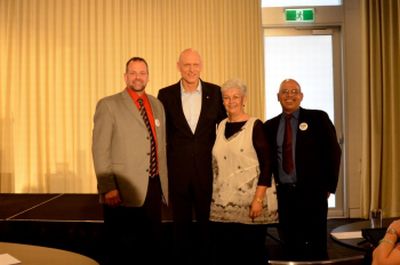
Matthew Koehler, Australian Minister for School Education Peter Garrett, Toni Downes, president, Australian Council of Deans of Education, and Punya Mishra
Back in 2006, professors Matthew Koehler and Punya Mishra introduced a concept called TPACK. Building on Lee Shulman’s idea of PCK, they argued that teacher knowledge in the 21st Century requires the integration of Technology, Pedagogy and Content (hence TPACK). Since then, the TPACK framework has been gaining traction in the educational research community and in a growing number of classrooms, both at the K-12 and college levels.
Now, an entire continent has adopted the model as a way to improve teacher preparation.
Koehler and Mishra, both faculty members in Educational Psychology and Educational Technology, were invited to Australia this spring to share their vision for producing educators with TPACK – the skills teachers need to integrate the right technologies based on what they are teaching (content) and what methods they are using (pedagogy).
All 39 teacher education institutions in Australia, plus some private universities, have been participating in the Teaching Teachers for the Future project, an initiative funded by the Australian Government. Toni Downes, who leads the nation’s council of education deans, said the project is focused on systematically changing the Information and Communication Technology (ICT) proficiency of teachers across Australia.
“The strength of the TPACK model is that it is easy to understand but also has an intellectual rigour, which supports large-scale projects seeking to bring about radical change,” she wrote. “… It has significantly contributed to our success.”
Rather than prescribing specific courses or curriculum, each participating institution received funding for an expert who is working with faculty members to develop changes to their teacher preparation programs. They also have access to a wealth of digital resources.
“The project provides resources, tools and case studies to teacher educators,” Koehler said, “So that they can work together to figure out how to make their goals a reality.”
While TPACK continues to influence research and discussions around the world, “it’s exciting to see it actually taken as the basis for action,” Mishra said.




